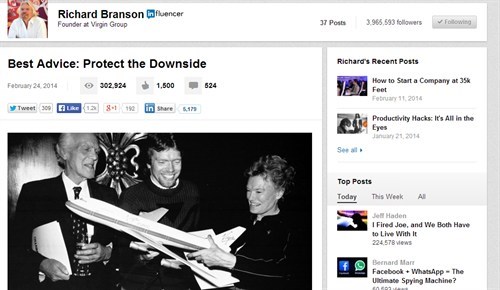Great Content: How to harness the power of the LinkedIn Influencer
28 February 2014
LinkedIn is a powerful social media platform. If you're jobhunting it's absolutely vital – a way for recruiters as well as future employers to have a look at you and your skills without needing to hunt for your CV.
If you're already in a job, it's a great way to network and find new business leads.Unlike Facebook and Twitter, people are more open to approaches – in the world of work, the more connections the better. It is a better fit for certain companies and brands, particularly if their focus is more B2B than B2C.
LinkedIn has become more of a natural fit for publishing complete articles, rather than simply providing links through a news feed. In connection with its news platform Pulse, LinkedIn has become a platform for big influencers to blog, share their business knowledge and express themselves to a new audience.
Open to all
The news LinkedIn is going to open this platform up for all is very interesting. Now all members have the opportunity to publish content, meaning they will be able to share their knowledge to a large audience already with a business mindset.
If you are thinking about it from the view of a content marketer, there's a lot of potential here. With blogs some companies find it difficult to get the right audiences reading through SEO or social media, particularly if B2B. B2C companies have it easier, as they don’t necessarily have to market specifically to people with an interest in what they create.
With the LinkedIn audience the right audience to a certain extent is already there – the content that you post will be shared with your trusted network who already have an investment with you. If the content is particularly valuable, this can reach an even larger audience of professionals.

Noise
If there is an issue, it could be that of quality control. If anybody can write and post content, it could mean a deluge of poor-quality posts written from a self-promotional point of view. This is a problem that has cropped up in Facebook, where news feeds can get clogged up with really annoying content (think pictures of babies and Buzzfeed quiz posts).
But to be fair, you would think businesses wouldn't like to publish rubbish content, as it could reflect quite badly on their brand. And poor-quality content wouldn't surface – algorithms and human editors would likely ensure that good content voted positively reached eyes, burying the bad stuff (though this isn't not always the case!).
LinkedIn the publishing platform
LinkedIn now has the ability to drive more traffic through content, without actually having to put any effort in creating any. Its ever-growing professional audience will be the content creators, which means companies will should soon make this part of their content strategy.
For B2B businesses this could be a goldmine in terms of creating new relationships with the right people. But it doesn't change the fact that content has to be high-quality for them to get the most out of it – and that's still the big challenge to face for many firms.

